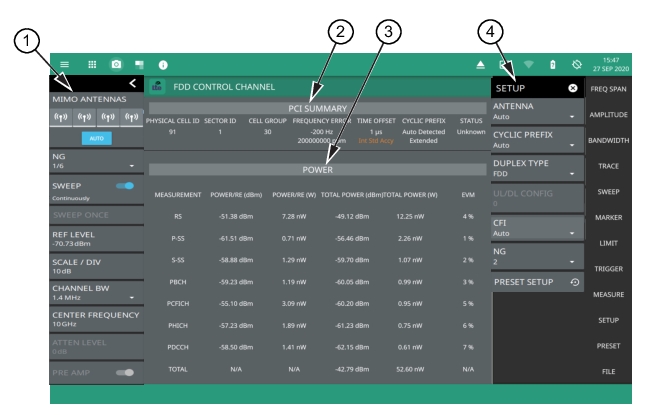 |
1. LTE Analyzer Status Panel: Each measurement features a unique status panel that displays settings and information relevant to the current measurement and view settings. This panel provides quick access to the MIMO antenna selection and status, NG parameter, sweep setting, and channel bandwidth configuration. See Status Panel (LTE Control Channel). 2. PCI SUMMARY: This area shows the physical cell ID, including the sector ID, cell group number, frequency error, time offset, cyclic prefix, and sync status. Sync status can indicate if there is a PSS or SSS failure, a Full Sync, or an Unknown condition. Also noted is the instrument’s reference clock accuracy of Internal, External, or GNSS (GPS) high accuracy (requires GPS). 3. POWER: Shows power levels in dBm and watts of each physical layer control: • Reference Signal (RS) Power: The reference signal is used for downlink channel estimation. • Primary Synchronization Signal (P-SS) Power. The primary sync signal is used to obtain slot synchronization. It contains information needed for cell search. • Secondary Synchronization Signal (S-SS) Power: The secondary sync signal is used to obtain frame synchronization and cell identity. It contains information needed for cell search. • Physical Broadcast Channel (PBCH) Power: This physical channel carries system information for user equipment (UE) requiring access to the network. • Physical Control Format Indicator Channel (PCFICH) Power: This channel provides information to enable the UE to decode the PDCCH and PDSCH channels. • Physical Hybrid Automatic Repeat Request Indicator Channel (PHICH): Transmits the channel coded HARQ indicator codeword used for error correction. • Physical Downlink Control Channel (PDCCH): Physical channel that carries downlink control information (DCI) such as scheduling assignments and other control information. • TOTAL: Displays total POWER/RE (power per resource element) and POWER in dBm and watts. The total power for a signal is calculated as the product of the EPRE (Energy per Resource Element) for the signal and the number of REs in one unit (sub-frame, half-frame, or frame) depending on periodicity of the signal in the frame (signal present in every sub-frame, half-frame, or frame), averaged over the number of symbols in the same unit over which REs are counted. Total EVM is not calculated. 4. SETUP Menu: The control channel measurement settings are configured in the SETUP menu. See SETUP Menu (LTE Control Channel). |

